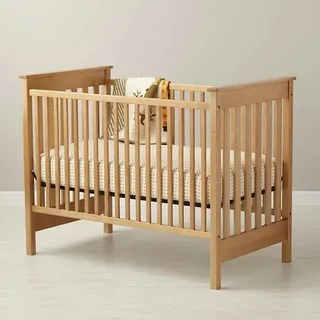Introduction
Welcoming a new baby into your home is an exciting and joyous time. Among the many decisions you’ll make, selecting the perfect crib is one of the most important. A natural wood crib not only ensures a safe and healthy sleeping environment for your little one but also brings timeless style and eco-friendly benefits to your nursery. In this guide, we’ll explore everything you need to know about choosing the best natural wood crib for your baby.
Why Choose a Natural Wood Crib?
1. Eco-Friendly and Sustainable
Natural wood cribs are made from renewable resources, making them an environmentally responsible choice. Many manufacturers prioritize sustainability by sourcing wood from certified forests and using non-toxic finishes.
2. Non-Toxic and Safe
Babies are sensitive to harmful chemicals, so choosing a crib made with natural wood and free from toxic paints or stains ensures a healthier environment. Look for certifications like GREENGUARD Gold to confirm low chemical emissions.
3. Durability and Longevity
Wood is a sturdy material that can withstand years of use. Natural wood cribs often convert into toddler beds or daybeds, extending their usability and offering excellent value for money.
Features to Look for in a Natural Wood Crib
1. Material and Build Quality
Select cribs crafted from solid hardwoods like maple, oak, or birch. These materials are not only durable but also visually appealing. Avoid cribs with particleboard or MDF components, as they may contain harmful adhesives.
2. Safety Standards
Ensure the crib meets safety regulations, such as those set by the Consumer Product Safety Commission (CPSC). Check for features like fixed sides, proper slat spacing, and a sturdy frame.
3. Adjustable Mattress Height
Choose a crib with adjustable mattress settings to accommodate your growing baby. This feature allows you to lower the mattress as your child becomes more mobile, preventing falls.
4. Convertible Options
Many natural wood cribs can transform into toddler beds, daybeds, or even full-size beds, making them a long-term investment. Check the conversion kit availability and ease of transformation.
5. Aesthetic Appeal
Natural wood cribs come in various finishes and styles, from minimalist to ornate designs. Choose a finish that complements your nursery decor and highlights the wood’s natural beauty.
How to Care for Your Natural Wood Crib
1. Regular Cleaning
Wipe the crib with a soft, damp cloth to remove dust and dirt. Avoid harsh chemicals, as they can damage the wood and compromise its safety.
2. Inspect for Wear and Tear
Periodically check for loose screws, cracks, or splinters. Tighten any loose components to ensure the crib remains secure.
3. Protect from Moisture
Keep the crib away from direct sunlight and humid areas to prevent warping or discoloration.
Top Benefits of a Natural Wood Crib
- Healthier Sleep Environment: Free from harmful chemicals, natural wood cribs promote better air quality in the nursery.
- Timeless Design: The elegant and classic look of natural wood complements various decor themes, ensuring a stylish nursery.
- Eco-Conscious Choice: By opting for sustainable materials, you’re contributing to a healthier planet for future generations.
Conclusion
A natural wood crib is more than just a piece of furniture; it’s a safe haven for your baby’s dreams and a beautiful addition to your home. With eco-friendly benefits, timeless aesthetics, and unparalleled durability, it’s a choice that aligns with both your parenting and environmental values. By considering key features, caring for the crib properly, and prioritizing safety, you can create a cozy and secure space for your little one to thrive.
FAQs
1. What is the best type of wood for a crib?
Hardwoods like oak, maple, and birch are excellent choices due to their durability and strength. These woods also showcase beautiful natural grain patterns.
2. Are natural wood cribs safe for babies?
Yes, as long as they are free from toxic finishes and meet safety standards. Look for certifications like GREENGUARD Gold to ensure low chemical emissions.
3. How can I tell if a crib is eco-friendly?
Eco-friendly cribs often come with certifications from organizations like FSC (Forest Stewardship Council). Check the product description or ask the manufacturer for details.
4. Can I paint or refinish a natural wood crib?
It’s best to avoid refinishing cribs unless you use baby-safe, non-toxic paints or stains. Always follow manufacturer guidelines.
5. How long can my baby use a natural wood crib?
Most cribs can be used until your child is 3-4 years old. Convertible cribs offer extended use by transitioning into toddler or full-size beds.







